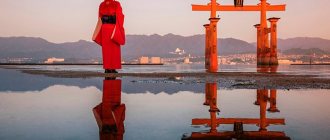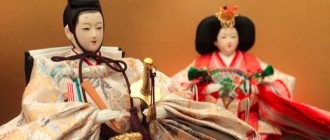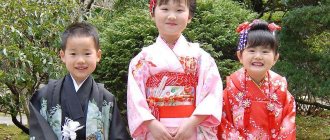Cherry blossoms
For example, countless works of literature use the metaphor of the short lifespan of cherry blossoms. Blooming dust quickly fades and falls to the ground (death). The Japanese understand that the life of a flower is too short. The cherry blossom reflects us humans, and we are ready to accept death, the Japanese believe. This may be one of the reasons why cherry blossoms look so deep and beautiful to the Japanese. This is a unique, typically Japanese way of thinking about cherry blossoms.
Another example is "Wabi-sabi". This movement is widespread in all aspects of Japanese art, literature, philosophy and thought. The figure of nature, objects, and relationships with living things are an important part of this beauty-oriented worldview, such as imperfection and fragility.
There are well-known examples of the aesthetics of wabi, dry sansui (for example, the stone garden of a Zen temple), ceramics that were specially made to emphasize naturalness, to emphasize nature.
https://masakaru.ru/isskustvo/iskusstvo/ikebana.html
There are wooden buildings that harmonize and do not stand out in the surrounding nature.
- Even the most sacred temple of Ise in Shinto is a living example of Wabi-Sabi. In fact, temples and shrines are destroyed once every 20 years and then rebuilt from scratch. To physically express the importance of beauty and fragility, what better way to learn through religion that it is strongly connected to the natural world?
Additionally, the Japanese often use natural and seasonal elements when writing things in all forms, be it poetry, prose, or letters to friends. A formal letter usually begins by mentioning the seasons. Haiku traditionally emphasizes nature as a subject. Additionally, metaphors using nature are very common in literature.
- There is no doubt about the importance of nature in Japanese culture. The Japanese view of these four seasons is very different, especially from Western concepts.
23 WISDOM OF ZEN BUDDHISM
Morning freshness of plum
Japan is not the only country famous for its flower-watching traditions. Koreans, no less than their neighbors, enjoy the charm of subtle colors, ephemeral beauty and romantic charm. The “model” is again cherry—though not Japanese, but a separate local species. In addition, Koreans enjoy contemplating the plum tree - its flowers are larger in size and less saturated pink in color. Cherry trees in the southern Korean Peninsula will bloom on average six days earlier than usual this year, the Korea Meteorological Service said Thursday. According to weather forecasters, the early cherry blossoms are favored by the warm weather that has prevailed since the end of February throughout the country. Around March 21, cherry trees bloomed on Jeju Island, and by the end of the month, in the southern provinces of Gyeongsangdo and Jeollado. During the first week of April, cherry trees in the central regions of the country will be covered with flowers.
However, you can find few Japanese people who want to get into untouched nature.
In fact, few Japanese people want to stay in untouched and wild nature for long. Rather, the Japanese prefer "pure" natural spaces such as landscaped gardens, bonsai, ikebana and well-kept thermal baths.
From the point of view of Western people, these spaces belong to different categories of nature. For many Westerners, “nature” and “wild” mean magnificent rivers, high mountain ranges, forests and vast fields.
In contrast, in Japan it is quite common to refer to gardens and parks as natural. If they are filled with trees, flowers and water, they are considered natural landscapes. Both untouched, primitive nature and “pure nature” fall into the category of nature.
Tokyo
- What Westerners call nature, undeveloped, dirty, remote, places with water and snow, are dangerous and terrible places from the ordinary Japanese point of view.
The Japanese fear of nature is largely based on the reason that most people in the country live an overly urbanized life. The 2010 census shows 90.7% of Japan's total population lives in cities.
Gaming machines
- But the main reason why Japanese people should keep their distance from nature is that Japanese nature can be truly terrible.
Cult of beauty
The Sakurajima volcano on the southern island of Kyushu embodies the combination of rage and affection, the unbridled destructive forces of nature and the perseverance of the creative man. Petrified lava flows have been transformed into stepped terraces of orchards. It seems as if tangerine trees are strewn with white flowers. But these flowers are paper. With such a small bag, a diligent gardener carefully covers each ovary.
Let the nature of Japan sometimes be cruel to people. Let her be stingy. But it is enough to visit these islands to understand why their inhabitants deify their native nature.
The concept of picturesqueness is expressed among the peoples of the Far East with the words “mountains and waters.” In Japan, such elements of beauty are truly ubiquitous. This is a country of forested mountains and sea bays.
The nature of a wide variety of climatic zones is represented in a relatively small area. Bamboo, bent under the weight of snow, is a symbol of the fact that north and south are adjacent here. The Japanese islands lie in the monsoon wind zone. At the end of spring and beginning of summer, masses of moist air from the Pacific Ocean bring heavy rains, which are so necessary for rice seedlings. In winter, cold winds from Siberia collect moisture over the Sea of Japan and bring to the northwestern coast of the Land of the Rising Sun the largest amount of snow in the world for these latitudes.
The combination of monsoon winds, warm sea currents and subtropical latitudes has made Japan a country with a unique climate, where spring, summer, autumn and winter are extremely clearly defined and replace each other very punctually.
The Japanese find joy in not only following this change, but also subordinating the rhythm of their lives to it. They are characterized not so much by the determination to conquer nature, but by the desire to live in harmony with it.
This same trait permeates their art. The goal of the Japanese gardener is to recreate nature in miniature. The craftsman strives to reveal the texture of the material. Cook - preserve the original taste of the product.
Aji-no-moto is a universal seasoning among Japanese chefs. The word literally means “root of taste.” The purpose of aji-no-moto is to enhance the inherent taste characteristics of products.
We can say that Aji-no-moto symbolizes Japanese art in general. His goal is to bring the material to a state in which it would most fully reveal its original charm.
The inherent love of nature for the Japanese is embodied in the unique features of national life. A Japanese house is like a canopy over emptiness. Each room has a wall that can be moved apart or removed altogether.
When such doors serve as external walls, they are covered with white rice paper and are called “shoji”. And those that divide the interior space and also serve as sliding doors are called “fusuma”.
When you first see the inside of a Japanese home, what is most striking is the almost complete absence of furniture. The eye sees only the bare wood of the support pillars and rafters, the ceiling of planed boards, the shoji latticework, the rice paper of which softly diffuses the light breaking through from outside. Under your bare feet, tatami—hard mats made of quilted straw mats—slightly spring. The floor, made up of these golden rectangles, is completely empty.
Of course, the design features of the Japanese house are generated by the constant threat of earthquakes. Although a wooden frame shakes during earthquakes, it is much more resistant than brick walls. And if the roof does collapse, the frame can be easily reassembled.
The sliding walls of a Japanese home undoubtedly embody the desire of its inhabitants to be closer to nature, instead of shutting themselves off from it.
The desire for harmony with nature and the cult of its beauty are the main features of the Japanese way of life. Experts admit that this character trait is actively nurtured by the local school from childhood. On a fine day, classes in classrooms are often canceled so that the children can go outside to draw from life or listen to the teacher explain how to recognize beauty.
An important place in the aesthetic education of a child is occupied by learning to write. There is no doubt that hieroglyphs are a heavy burden for a Japanese schoolchild. It takes him three to four times more time and effort than mastering his native language in other countries.
But something else cannot be ignored. When studying hieroglyphs, the line between penmanship and drawing is blurred. Perfect mastery of the brush and an impeccable sense of proportions, necessary for hieroglyphic writing, make a literate Japanese also a skilled painter.
The customs of collective admiration of the most poetic phenomena of nature are firmly rooted in the everyday life of the Japanese. In winter it is customary to enjoy freshly fallen snow, in spring - cherry blossoms, in autumn - the crimson leaves of maples and the full moon.
This is not about some select class. Automobile factories, electrical concerns, and fishing cooperatives hire entire excursion convoys for this purpose. Thanks to additional tourist routes, such trips are quite accessible for any group and greatly brighten up the daily life of ordinary workers.
The Japanese find and appreciate beauty in what surrounds a person in his everyday life, in every object of everyday life. Not just a painting or a vase, but any household item, even a spatula for putting rice, can be the embodiment of beauty.
The tea ceremony also teaches us to find beauty in the ordinary. If the passions raging in the human soul give rise to certain gestures, then there are also gestures that can influence the soul and calm it. With strictly defined movements and their regularity, the tea ceremony calms the soul, brings it into a state in which it responds especially sensitively to the omnipresent beauty of nature.
In a Japanese home there is a niche where there is a vase with ikebana - a composition of flowers. Ikebana is an independent form of fine art. The closest thing to it is, perhaps, sculpture. The sculptor sculpts from marble and clay. In this case, he holds flowers and branches in his hands.
The purpose of Ikebana is to express the beauty of nature by creating arrangements of flowers and ceramics. The art of ikebana is loved in Japan for its universal accessibility, for the fact that it helps a person of any income feel spiritually rich.
Japan now represents a double example for humanity. On the one hand, with their way of life, the Japanese refute the speculation that modern civilization impoverishes a person’s spiritual life and obscures the world of beauty from him. On the other hand, the appearance of the Japanese islands, more alarmingly than other parts of the Earth, warns in our century against the disastrous consequences of unreasonable environmental management.
It cannot be said that Japan is picturesque only where its nature has remained untouched. Aren't the terraced rice fields created over many generations exciting to the soul? Or tea plantations, where the merging crowns of neatly trimmed bushes descend the slopes like giant snakes?
Well-groomed conditions, treating the field as a garden bed or flowerbed is a characteristic feature of Japan, one of the elements of its picturesqueness. Don’t the landscape beautify the landscape with concrete highways or cable-stayed bridges spanning the Inland Sea?
The Land of the Rising Sun testifies: human labor is capable of increasing the beauty of nature in proportion to the rationality of its application.
The Japanese have always coexisted with natural disasters.
Even Japanese hornets, which live in many areas of Japan, can cause death. Hornet stings cause excruciating pain.
Hornets
Jellyfish in many places across the country can be deadly, with some snake bites causing hospitalization or death. And don't forget the huge poisonous centipede (Tobismkade), straight out of horror movies, found in the countryside. They grow up to 30 cm in length, their bite causes severe pain, chills, fever, etc.
Centipede
Natural disasters often occur in Japan. Huge earthquakes and tsunamis, landslides, typhoons, volcanoes and floods. Of course, such natural disasters occur in different countries around the world, but it can be said that Japan is a country that is “in harmony with them.”
- The Great East Japan Earthquake, which struck the Tohoku region in 2011, is one of the largest earthquakes recorded in the world, and even in Japan, which boasts the world's most sophisticated earthquake prevention measures, 16,000 people were killed and 2,500 were missing. without a trace.
Fukushima.
The Great Kanto Earthquake of 1923 resulted in over 140,000 deaths from earthquake, fire and firestorm. The 2021 Kumamoto earthquake and severe floods caused by the heavy rains of 2021 destroyed the city and killed many people. Japan has always been a country that has dealt with a lot of natural disasters.
Now you can understand why there is a fear of nature in Japan. Unlike many countries in the West, Japan is a very dangerous place in terms of natural disasters.
- Of course, just because the Japanese have a certain sense of fear does not mean that they do not feel a deep connection with or respect nature. Nature may be terrifying, but at the same time, as mentioned above, it is clear that nature is immersed in Japanese art, lifestyle, culture and beliefs.
Photo 1900
Japanese thinking about nature is respected in the West.
These unique Japanese concepts of nature are quite different from those of Westerners, but recently they have gradually begun to spread throughout the world. Rather than being discouraged as being different from their own culture, Japanese thinking is quite respected around the world.
Rock garden
For example, Japanese gardens and Japanese art, literature and interior design, their stance on respect for nature based on religion such as Shinto and Zen , martial arts thinking, have many fans abroad.
Bonsai
“At Home Nature” is the safest way to enjoy the seasonal changes while connecting with nature. This is why landscaped gardens, bonsai, ikebana and seasonal flowers (such as cherries and plums) are important to these people. This is unique in Japan, it represents a deep respect for nature and its great power.
rock garden
Views: 2,335
Share link:
- Tweet
- Share posts on Tumblr
- Telegram
- More
- by email
- Seal
Liked this:
Like
Art at school
“Beauty is a bright light that illuminates the world, in this light truth, truth, goodness are revealed to you; illuminated by this light, you experience commitment and intransigence. Beauty teaches us to recognize evil and fight it. I would call beauty the gymnastics of the soul - it straightens our spirit, our conscience, our feelings and beliefs. Beauty is a mirror in which you see yourself and treat yourself accordingly.” Vasily Aleksandrovich Sukhomlinsky
Probably, people have always and everywhere admired the beauty of nature. But school lessons on admiring beauty are rare. There is such a lesson in Japanese schools. These are regular nature excursions where children are taught to admire nature.
It is no coincidence that such a lesson appeared in Japan. It is known that the Japanese can distinguish 240 shades of colors; the Japanese language has 24 words to denote the seasons. In Japanese culture, there are different types of admiring natural phenomena. Tsukimi - admiring the full moon in autumn, momijigari - admiring the changing colors of maple leaves in autumn, combinations of red, yellow and green foliage, yukimi - admiring the first snow in winter, hanami - admiring flowers, sakuramankai - admiring the cherry blossoms of sakura in early spring, hotarugari - admiring fireflies through the lens camera in the area of Maniwa and Okayama prefectures.
Japanese children do not take exams until grade 4. The main attention is paid to education. Children are taught respect for other people, self-control, respect for nature, playing the flute, and calligraphy. Children also learn to write traditional Japanese haiku poetry. Haiku are three verses that lyrically speak about nature and the author’s attitude towards it. For example, the haiku of the famous 17th century Japanese poet Matsuo Basho “Wildflower”:
A wildflower in the rays of sunset captivated me for a moment.
Lessons in admiring the beauty of nature are part of education. Gradually, children learn to see the beauty of various natural phenomena, and then move on to comprehend beauty in art - painting, classical music, literature and other forms of art. The ability to notice, see beauty, hear and feel - this is cultivated, and does not appear on its own.
A similar approach to education was in the “School of Joy” by Vasily Aleksandrovich Sukhomlinsky.
The teacher, who went through the horrors of the bloodiest and cruelest war in history, and who lost his family, taught children to see the beauty of nature, beauty in everything.
At Sukhomlinsky’s “School of Joy,” classes were often held outdoors, in nature. Children learned to see the beauty of the world around them and observe various natural phenomena. Sukhomlinsky believed that it is necessary to cultivate a sense of beauty in children in order to awaken in them good feelings for plants, living beings, and people - this is what prevents the emergence of cruelty and indifference that so worry us in the behavior of some children and adolescents.
It is communication with nature that fosters kindness and mercy, the ability to see beauty, develops observation, awakens creativity and responsibility for the environment.
“Beauty is the joy of your life. Man became Man because he saw the depth of the blue sky, the twinkling of stars, the pink spill of the evening and morning dawn, the crimson sunset before a windy day, the fluttering haze over the horizon, the boundless distance of the steppes, blue shadows in the snowdrifts of March snow, a school of cranes in the azure sky, reflection the sun in transparent drops of morning dew, gray threads of rain on a cloudy autumn day, a purple cloud on a lilac bush, a delicate stem and blue bell of a snowdrop - I saw and was amazed, and walked along the earth, creating new beauty,” noted Sukhomlinsky.
Communication with nature is necessary and important for a child. Such children get sick less, being in nature relieves stress, this scourge of the 21st century. Children develop a caring attitude towards the world around them.
Vasily Aleksandrovich Sukhomlinsky wrote: “To actively influence nature, but at the same time remain its son, to be the crown of its creation and at the same time the owner of its powers, to treat it with filial care - this is the attitude that should be cultivated in students in the process of their interaction with nature.” .
Man has acquired considerable power and the ability to repeatedly destroy all life on Earth. Let's teach children to appreciate and love nature, to see beauty, to create beauty, to direct knowledge and energy to take care of the world around us - our home!










